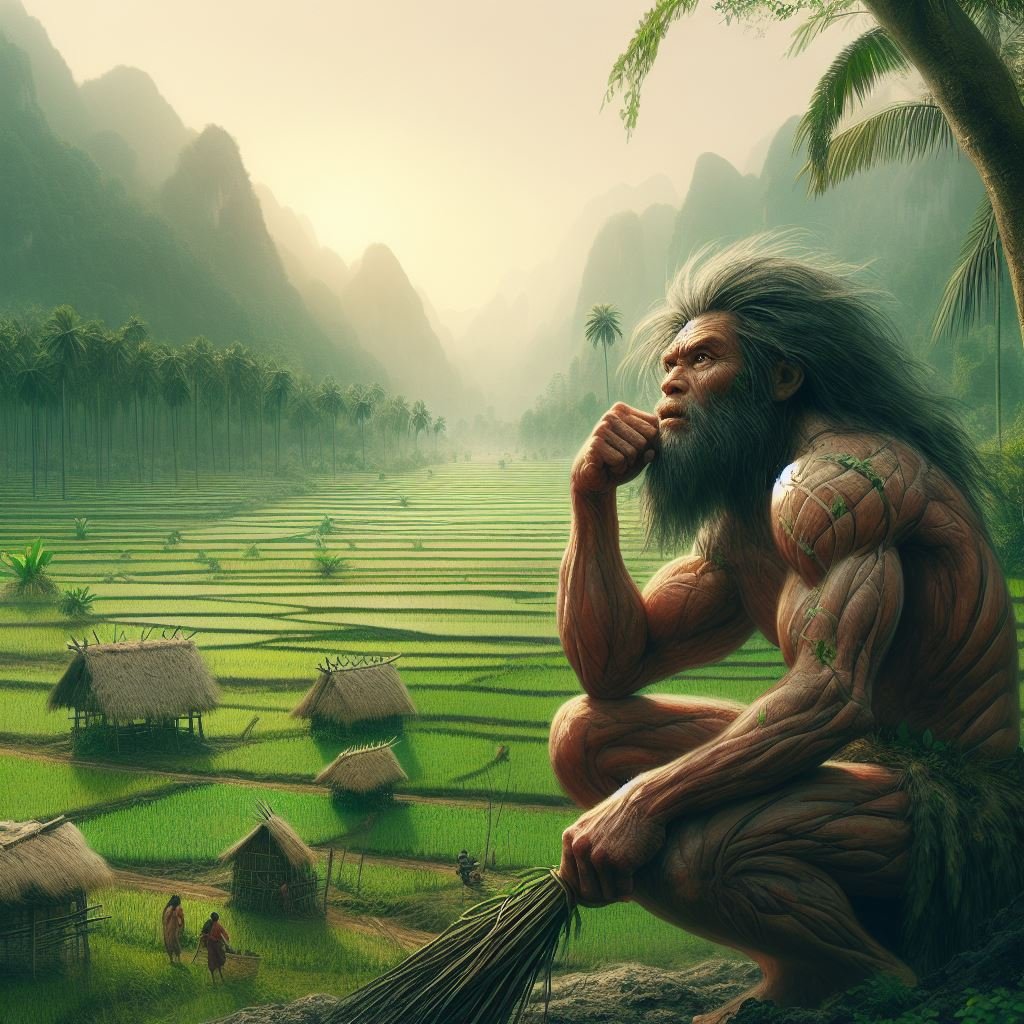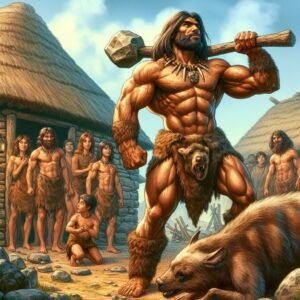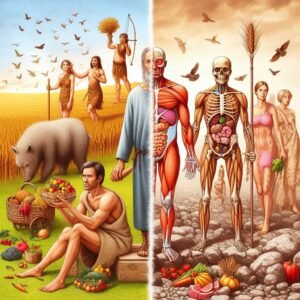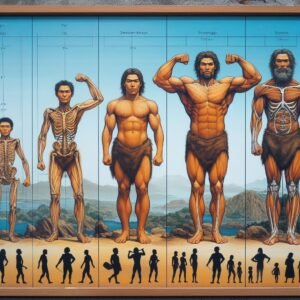
Human history is marked by pivotal moments that have shaped the course of civilizations, and among these, the advent of agriculture stands as a transformative milestone.
Agriculture has been hailed as the cornerstone of human progress for actually not so long!
Its just been 10,000 years that we stumbled upon agricultural practices and given the time frame of human existence on the planet , which is almost 6,000,000 years, agriculture is a fairly new vice that we are relishing!
The social fabric as we know it, as of today, has been formed due to agriculture when small groups of “weaklings” ( experts might call them smart but to me they were weaklings) started existing together as they had finally found a way for a regular food supply without even stepping into the darkness of the jungles.

They were no longer dependent upon the alphas of the clan/tribe to forage into the unknown only to come back with riches of food. Obviously, they were the ones who got to carry forward the progeny as women were attracted to them as they could provide food and safety to their future kids, not to mention the strength needed in those times to exist.
As they grew in numbers, more and more people joined them, obviously lured by the abundant food supply and a comparative lack of effort required to get it.
The Agricultural “revolution” brought about surplus food reserves and the uncertainty around food was a thing of the past. Or was it?
Could it had been humanity’s most significant misstep?
In exploring this contentious assertion, one has to acknowledge the multifaceted impacts that agriculture has had on human health, nutrition, and the environment as an individual or on the society as a whole.
Today you might leave with your hand in your mouth as rarely has been a blessing called a curse , a hero a villain, a boon a bane.
Health & Nutritional Consequences of Agriculture
1. Hunter-Gatherer’s Varied Diet vs. Early Farmer’s Reliance on Starchy Crops
In his seminal work “Guns, Germs, and Steel: The Fates of Human Societies,” Jared Diamond meticulously explores the historical trajectories that have shaped human civilizations.
In the context of dietary practices, Diamond provides a comprehensive analysis of the contrast between the varied diet of hunter-gatherer communities and the dietary transition observed in early agricultural societies.
Diamond underscores the hunter-gatherer lifestyle characterized by a diverse and flexible diet derived from a plethora of plant and animal sources. This dietary diversity is integral to the nomadic lifestyle, enabling these communities to adapt to the seasonal availability of resources and environmental fluctuations.
Worth noting is the anatomic evolution that had happened to the human body where it lost tyhe length of the large intestine and ended up having a longer small intestine which was needed to support the nomadic feast-or-famine eating lifestyle of the human. Its purpose was to provide maximum absorptive surface area and minimal storage after digestion.
The hunter-gatherers had an immensely varied diet which depended upon season and availability of food.
Contrary to the adaptive and diversified diet of hunter-gatherers, early agricultural societies underwent a profound dietary shift.
The focus shifted predominantly towards the cultivation and consumption of starchy crops such as wheat, rice, and corn. Diamond illuminates this pivotal transition, emphasizing the agricultural practices that led to the cultivation of a limited number of staple crops.
Diamond’s work provides a foundational understanding of the dietary dynamics at play during the shift from hunting and gathering to agriculture.

2. Reliance on limited plants and its consequences
Relying exclusively on three high-carbohydrate plants—wheat, rice, and corn—that lack certain essential nutrients raises significant concerns regarding the nutritional value of human diets. The limited diversity in these staple crops results in a specific set of nutritional deficiencies, which can have direct implications for human health.
One notable consequence is the insufficient intake of essential vitamins and amino acids necessary for overall well-being.
These crops, while serving as primary sources of calories, lack a comprehensive range of nutrients required for optimal human nutrition.
- Wheat:
- Essential Amino Acids: Wheat is deficient in lysine, an essential amino acid. While wheat contains protein, it is not considered a complete protein source due to this deficiency.
- Micronutrients: Wheat is generally lower in micronutrients like vitamins and minerals compared to some other grains.
- Rice:
- Micronutrients: Brown rice contains more nutrients than white rice, but both are relatively low in essential nutrients. They lack some important vitamins and minerals.
- Fiber: While brown rice has more fiber than white rice, both types are considered low in fiber compared to whole grains.
- Corn:
- Protein Quality: Corn protein is deficient in certain essential amino acids, particularly lysine and tryptophan. It is not a complete protein source.
- Micronutrients: Corn is not particularly rich in vitamins and minerals compared to other grains.
The deficiency in vital vitamins and amino acids lead to nutritional imbalances, potentially contributing to health issues such as vitamin deficiencies and protein inadequacies.
The narrow focus on these high-carbohydrate plants also overlooked the potential benefits of a more varied diet. Different plants contain distinct micronutrients, and a diversified selection of food of Paleolithic human, contributed to a broader spectrum of essential vitamins and amino acids.
As compared with the typical Western diet of today the hunter-gatherer diet(pre-agricultural humans) had some stark characteristics:
-
- It had a lower glycemic load( due to low carbohydrate density of food)
- It had higher fiber levels
- it had more protein and less carbohydrates
- it had more vitamins, minerals and phytochemicals
- The fatty acid intake was different (higher omega-3s, lower omega-6s, more highly unsaturated fatty acids of both omega-3s and omega-6s, lower trans fatty acids, higher monounsaturated fatty acids and polyunsaturated fatty acids)
For those who follow diets this is the basis of a Paleo Diet devised by Cordain Loren.
Researchers argue that our genes simply haven’t caught up with the dietary divergence and it could be causing – or at least contributing to- the epidemic levels of chronic disease, such as cardiovascular disease, cancer, diabetes, and obesity that we see today.
For the ones who swear by the concept of balanced diet, here is a kicker.
The preagricultural diet, contrary to popular belief of being “less” balanced than that of today , was actually more balanced. Actually the concept of balanced diet came up only when the researchers saw that what we were consuming was not the right diet that the humans needed.
Why do you think there is emphasis on more fiber intake( reduce glycemic load), more water( means less sodium is concentrated in the body), more greens( more phytochemicals), fish( more better fatty acids), more fruits( more minerals, more vitamins, more potassium).
The pre-agricultural humans had a much broader pattern of food consumption and though they may have been facing times of famine/starvation , overall when they were consuming the variety was vast, and so it was more balanced.
Compare it to today’s dietary habits where you have a small selection of superfoods. we are just dependent on wheat, rice and corn. Where is the balanced diet we want?
Currently, hundreds of diseases with no definite etiology inflict humanity, (diseases such as type 1 diabetes, multiple sclerosis, rheumatoid arthritis). An increasing body of evidence is now holding diet as the environmental trigger that might be responsible for the development of these diseases in genetically susceptible individuals( and we discussed humans have had not enough time to evolve genetically to adapt to this new diet of the post agricultural era)
Even more shocking is the fact that the dietary factors in all of these diseases are foods and food groups introduced after the advent of agriculture.
It seems so easy but foolish how cheap calories were gained at the expense of nutritional value.

If that’s not enough Archaeologists have unearthed bodies of humans that belong to the pre and post agricultural eras.
Surprisingly, the bodies found after the agriculture, supposedly provided good food supply, were found to be deficient in calcium and iron.
This shows that the early agricultural societies transitioned their dietary focus towards starchy crops, providing a reliable source of abundant calories. However, this shift came at the cost of compromising the overall nutritional value of the diet.
This historical analysis, grounded in paleopathological evidence, significantly contributes to our comprehension of the intricate relationship between dietary choices, nutritional value, and the overall health and well-being of early agricultural societies.
So ,it is clear now that, agriculture is killing us gradually.
We are living in an age of chronic diseases. Obesity, hypertension and diabetes are like life long companions to our new borns. Heart attacks in the 20s is now a “normal” thing.
Would it have been different if we stayed hunter gatherers? Or are we taking enough steps to reverse the ill doings of agriculture? Have we crossed the point of no return and humans will form the fifth mass extinction on planet earth?
We will get to that at the end of the discussion as its not just nutrition that spoiled the whole progress og humanity but other things as well.
Let’s see!
Environmental Impact of Agriculture
1.Consequences of Monoculture
Monoculture, the systematic cultivation of a single crop over expansive areas, wields a considerable influence on soil health and fertility.
This leads to the disruption of nutrient cycling within the soil.
Further , forests are being cut to make way for agricultural land as our population continues to grow.
The conversion of natural lands to agricultural uses is a significant threat to biodiversity and ecosystems.
Later, the exclusive cultivation of a single crop can lead to imbalances, ultimately diminishing the overall fertility of the soil.
Monoculture is intricately linked to
-
-
- landscape simplification
- encapsulating the expansion of cultivated land
- the reduction of plant species diversity across landscapes
- alterations in biotic interactions
- the implementation of highly intensive management practices.
-
These simplification processes are pervasive across various levels, occurring at the field, farm, landscape, and regional scales. Monocultures consistently exert detrimental effects on species richness when compared to alternative land uses. Furthermore, these monocultures contribute minimally to natural habitat creation.
This interconnected web of consequences emphasizes the broad-ranging impact of monoculture, extending from localized ecosystems to larger regional landscapes.
Furthermore, our discussion extends to the structural integrity of the soil under the persistent influence of monoculture. Insights from researchers from world over provide valuable perspectives on how monoculture contributes to soil compaction, diminishing porosity, water retention, and nutrient accessibility. These alterations in soil structure not only impede the optimal growth of crops but also amplify the vulnerability of agricultural landscapes to erosion and degradation.

And..it will not be rocket science to understand what erosion and degradation of our lands will do to humanity. But still , laying it out for you:
-
-
- Reduced Productivity
- Threat to Food Supply
- Sedimentation in Water Bodies
- Climate Change
- Habitat Destruction
- Infrastructure Damage
- Increased Vulnerability to Natural Disasters
- Shrinking Agricultural Land
- Dust and Air Quality
- Conflict Over Resources
-
These will definitely not help humanity.
Will it?
Societal Vulnerability and Economic Impact
1.The Risk of Starvation due to Dependence on a Limited Number of Crops
History is our best guide and teacher.
Historical instances of societies facing severe crises and the imminent threat of starvation due to crop failures are numerous. Here are a few notable examples:
1. Irish Potato Famine (1845-1852)
The Irish Potato Famine was a devastating period in Ireland when a potato blight led to the failure of the primary food crop, the potato.
The ensuing famine resulted in the death and emigration of millions of people, significantly impacting Irish society.
2. Great Chinese Famine (1959-1961)
A combination of natural disasters, including droughts and floods, coupled with misguided agricultural policies, led to a severe famine in China.
The Great Chinese Famine caused the deaths of tens of millions of people and had profound social and economic consequences.
3. Bengal Famine of 1943
During World War II, Bengal, India faced a severe famine exacerbated by a combination of factors, including Japanese occupation, natural disasters, and mismanagement of resources.
The famine resulted in the deaths of millions of people and had lasting impacts on the region.
4. Dust Bowl (1930s, United States)
The Dust Bowl was a series of severe dust storms that ravaged the Southern Plains of the United States during the 1930s.
Poor agricultural practices, coupled with drought, led to widespread crop failures, soil erosion, and economic hardship for many farming communities.
5. North Korean Famine (1990s)
In the 1990s, North Korea experienced a severe famine due to a combination of natural disasters, economic mismanagement, and the collapse of the Soviet Union.
The famine resulted in widespread starvation and had long-term effects on the country’s population.
These instances highlight the vulnerability of societies to food shortages and famine when heavily reliant on a limited number of crops or when facing adverse environmental conditions. They underscore the importance of diversified agriculture, sustainable practices, and effective food distribution systems in ensuring food security and preventing humanitarian crises.
So when we look back in history where societies faced severe crises and the imminent threat of starvation due to crop failures it will become evident that a hunter gatherer was not faced with such extreme starvations as they depended upon varied types of foods. The modern human unfortunately doesn’t have that privilege.
2.The Social and Economic Shifts Brought About by Agriculture
a.the Impact of Crowded Societies on the Spread of Infectious Diseases:
The shift towards agriculture led to the formation of crowded societies and the subsequent increased risk of infectious diseases.
If we analyze historical patterns to understand the correlation between population density, agriculture, and disease spread.
**The Impact of Crowded Societies on the Spread of Infectious Diseases:**
The transition to agriculture marked a pivotal point in human history, influencing not only societal structures but also contributing to the formation of crowded settlements. This shift from nomadic lifestyles to settled agricultural communities brought about a complex interplay between population density, agricultural practices, and the increased risk of infectious diseases.
Historical Patterns and Correlation
1. Sedentary Lifestyle and Population Density
As communities adopted agriculture, the sedentary lifestyle allowed for larger and more concentrated populations. This increased population density created favorable conditions for the transmission of infectious diseases.
2. Domestication of Animals
The practice of agriculture often involved the domestication of animals, leading to closer human-animal interactions. This proximity created opportunities for zoonotic diseases (diseases transmitted between animals and humans) to jump species barriers, contributing to the spread of new infections.
3. Limited Sanitation Infrastructure
Crowded societies, often lacking advanced sanitation infrastructure, faced challenges in waste disposal and maintaining clean water sources. These conditions provided breeding grounds for waterborne and vector-borne diseases.
4. Trade Networks and Disease Transmission
Crowded settlements engaged in trade, facilitating the movement of goods and people across regions. This interconnectedness played a role in the rapid spread of infectious diseases along trade routes.
5. Crowding and Respiratory Infections
The close proximity of individuals in crowded settings increased the likelihood of respiratory infections spreading. Diseases such as influenza found ideal conditions for transmission in densely populated areas.
b.The Interconnectedness of Crowded Societies and Agriculture
Assessing the intricate relationship between crowded societies and agricultural practices makes us realize how the concentration of populations in dense settlements, often driven by agricultural practices, facilitated the spread of diseases and altered societal dynamics.
Population Density and Agricultural Practices
1. Urbanization and Agricultural Surpluses
The advent of agriculture allowed for the generation of food surpluses, enabling the growth of larger populations. As surplus food could sustain non-farming populations, urbanization became possible, leading to the formation of crowded cities.
2. Specialization and Trade
Agricultural surpluses facilitated specialization, with individuals engaging in professions beyond farming. Trade networks developed, connecting crowded urban centers with agricultural hinterlands. This symbiotic relationship between agriculture and urban centers influenced economic and cultural exchanges.
3. Disease Transmission in Crowded Settings
The concentration of people in urban areas created ideal conditions for the spread of infectious diseases. Crowded living conditions, limited sanitation, and close human-to-human interactions contributed to the transmission of diseases, a phenomenon historically observed in densely populated cities.
Societal Dynamics and Agricultural Impact
1.Social Stratification
The concentration of people in crowded societies often led to social stratification.
Agricultural practices, particularly those that yielded surplus resources, contributed to the emergence of social hierarchies, altering power dynamics within communities.
2. Technological Advancements
The demands of sustaining crowded populations drove technological advancements in agriculture. Innovations such as irrigation, crop rotation, and animal domestication emerged to meet the needs of growing urban centers.
Potential Implications for the End of Humanity:
The interplay of societal vulnerability and economic impact, rooted in the dependence on a limited number of crops and the social shifts brought about by agriculture, can have profound consequences that may pose existential threats to humanity.
- Food Scarcity and Societal Collapse:
- Overreliance on a narrow range of crops makes societies vulnerable to crop failures, which historically have led to famine and societal collapse. The potential for widespread food scarcity, aggravated by factors such as climate change and monoculture practices, could intensify the risk of societal breakdown.
- Pandemics and Population Decline:
- Crowded societies, a consequence of agricultural practices, create favorable conditions for the spread of infectious diseases. Covid-19 cases worldwide stood at 774,075,242 reported cases on 7 January 2024. The pandemic continues.
- Covid-19 had proved that right , if anyone had any doubts about occurence of a Pandemic( I did. Had always read about pandemic in Medical School but never had I ever thought of witnessing one, let alone being one of the sufferers)
- If left unchecked, pandemics facilitated by such conditions could lead to significant population declines (Covid -19 deaths stood at 7,012,986 deaths on 7 january 2024), affecting societal structures and resilience.
- Economic Instability and Social Unrest:
- Economic impacts stemming from agricultural vulnerabilities, such as crop failures, can trigger social unrest and instability. This, coupled with the interconnectedness of agriculture and societal structures, may result in a domino effect affecting global economies and governance.
- Environmental Degradation and Resource Depletion:
- Intensive agricultural practices, when unsustainable, contribute to environmental degradation and resource depletion. The long-term consequences may lead to a collapse of ecosystems and essential resources, further exacerbating the challenges faced by humanity.
While these scenarios represent extreme possibilities, they underscore the importance of addressing agricultural practices, promoting sustainable food systems, and understanding the intricate connections between societal vulnerability, economic impact, and the potential risks to the continuity of human civilization.
Contemporary Relevance: Modern Agricultural Challenges
A. Connection of Historical Data to Present-Day Agricultural Practices
1. Parallels Between Early Agriculture and Current Challenges
Drawing parallels between historical agricultural practices and contemporary challenges provides valuable insights. For example, the historical reliance on a limited number of crops and monoculture practices can be compared to present-day agricultural systems that face similar issues.
Parallel 1: Monoculture Practices:
The historical trend of relying on a few staple crops, as observed in early agriculture, has persisted in modern monoculture practices. Large-scale cultivation of a limited number of crops for global food production remains a challenge, impacting biodiversity, soil health, and resilience to pests and diseases.
Parallel 2: Environmental Impact:
Early agricultural practices contributed to environmental changes, and today, modern agriculture faces challenges related to environmental degradation, deforestation, and excessive use of agrochemicals. The parallels highlight the importance of sustainable agricultural practices to mitigate negative environmental impacts.
2. Potential Consequences of Continued Reliance on a Limited Number of Crops
Examining the potential consequences of continued reliance on a narrow range of crops is crucial for addressing current challenges and fostering sustainable agricultural practices.
Consequence 1: Genetic Vulnerability:
Continued dependence on a limited number of crops heightens the risk of genetic vulnerability. This makes crops susceptible to diseases and pests, posing a threat to global food security. Diversifying crop varieties can enhance resilience and reduce the risk of widespread crop failures.
Consequence 2: Soil Health and Nutrient Depletion:
Monoculture practices contribute to soil degradation and nutrient depletion. Exploring ways to promote diverse crop rotations, cover cropping, and agroecological approaches is essential for maintaining soil health and fertility in the long term.
Consequence 3: Climate Change Resilience:
A limited crop variety may be less resilient to the impacts of climate change. Identifying and implementing climate-resilient crops and farming practices is crucial for adapting to changing climatic conditions.
Connecting historical data to present-day agricultural practices allows us to learn from past challenges and devise sustainable solutions. By identifying parallels and discussing potential consequences, we can develop strategies to address modern agricultural challenges and move towards a more resilient and environmentally sustainable food system.
The Echoes of Our Agricultural
As we navigate the fields of our past, tilling the soil of ancient choices, we unearth the profound echoes of humanity’s biggest mistake – agriculture.
The seeds we sowed in those distant days have grown into a complex tapestry, woven with both sustenance and thorns.
In the quiet rustle of the wind through golden wheat fields, one can almost hear the whispers of our ancestors, whose quest for stability birthed a paradigm that now tests the very foundations of our existence. The same fields that once promised abundance now carry the weight of our agricultural legacy, a legacy etched with stories of both triumph and despair.
As we stand at the crossroads of progress and reflection, let the haunting silhouette of our past stand against the horizon be a reminder. The same fertile grounds that yielded civilizations now challenge us to redefine our relationship with the land beneath our feet.
In the gentle sway of crops, we discern the heartbeat of an Earth burdened by the consequences of our choices.
The realization echoes like a distant thunder – agriculture, the double-edged scythe that brought sustenance and shackles, is a tale etched in the soil. The mistake, not in the quest for sustenance, but in the unchecked path we carved, leaving behind a landscape that bears witness to both our triumphs and our follies.
So, as we plow the fields of tomorrow, let the furrows be lined with seeds of wisdom.
For in acknowledging our missteps, we find the courage to cultivate a future where the soil sustains not just our hunger, but our harmonious coexistence with the Earth. The goosebumps rise not in fear of our past but in the anticipation of a new chapter – a chapter where we learn from the fields we planted, nurture diversity, and, in doing so, unearth the promise of a more balanced and sustainable existence.







